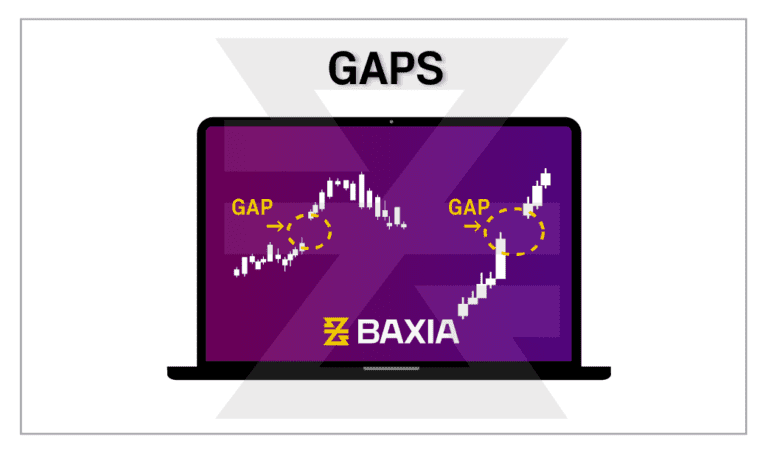- CFDs & Forex Trading | Regulated Online Trading
- About Us
- Trading
- Platforms
- Resources
- Partners
- Research
Search
×

Gaps are spaces on a chart where no trading activity has taken place, representing a sharp move in price. In the stock market, they are common due to overnight news or events affecting a stock’s price before the next opening. While less prevalent in the Forex market due to its 24/5 operation, gaps can still occur after weekends or major unforeseen events. Understanding gaps is crucial as they can provide insight into potential future price movements.
QUICK LINK TO CONTENT

A gap is defined by the price jump between the close of one period and the open of the next, without any trading activity in between.
Types of Gaps
• Common Gaps:
These are not associated with any significant news event and are generally filled quickly. They're a result of normal price fluctuations and might not signal any major change in trend.

• Breakaway Gaps:
Occur at the beginning of a new trend, often after a key news announcement or a significant event. This type of gap signals the start of a new movement and might not be filled for a long time, if ever.
• Runaway (or Continuation) Gaps:
These gaps happen in the middle of a price trend and signal the continuation of the current trend. They're usually accompanied by high volume and can be a strong indication of market sentiment.
• Exhaustion Gaps:
Occurring towards the end of a price trend, exhaustion gaps signal that a trend is nearing its end and a reversal might be imminent. This is typically the last push before prices start to move in the opposite direction.
• Entry & Exit Points with Gaps:
Gaps can provide clues for potential entry or exit points. For instance, a breakaway gap might offer a good entry point into a new trend, while an exhaustion gap could be an indication to exit or even reverse a position.
• Setting Stop-losses:
The opposite side of a gap can serve as a reference point for setting stop-loss orders. If a gap is genuinely a continuation or breakaway gap, the price shouldn't return to the pre-gap levels.
• Gap Fill:
Prices often move back to fill the gap, but not always. Understanding the type and cause of the gap is crucial to predict whether it will be filled.
• Volume Confirmation:
A gap accompanied by significant volume often provides stronger confirmation about its type and potential longevity.
• Forex Specifics:
In Forex, gaps are rarer due to the 24/5 market operation. When they do occur, they carry significant importance, often driven by weekend news or unexpected global events.
• Island Reversal:
This is a situation where a gap is followed by a short price movement and then another gap in the opposite direction. This leaves a range of prices isolated or "stranded," resembling an island. It's a strong reversal signal.
Gaps have been observed and analyzed in various financial markets for decades. They’re often viewed as strong indicators of market sentiment, especially when backed by volume and other confirmatory signals.
While gaps might be less common in Forex CFD trading due to the continuous nature of currency markets, when they do appear, they can provide significant trading opportunities. Recognizing the type of gap and understanding its implications are essential for making informed trading decisions. As always, gaps should be interpreted in conjunction with other technical analysis tools and within the context of a comprehensive trading strategy.
Want to learn more? Discover more important concepts used in technical analysis for forex trading below
Start placing forex trades with a Baxia trading account
Looking for more?
Explore our Education Center
View our collection of free education resources dedicated to help you become a more informed and confident trader.
BAXIA GLOBAL LIMITED
Join the community
Risk Warning: Margin trading involves a high level of risk, and may not be suitable for all investors. You should carefully consider your objectives, financial situation, needs and level of experience before entering into any margined transactions with Baxia Markets, and seek independent advice if necessary. Forex and CFDs are highly leveraged products which mean both gains and losses are magnified. You should only trade in these products if you fully understand the risks involved and can afford losses without adversely affecting your lifestyle (including the risk of losing the entirety of your initial investment). You must assess and consider them carefully before making any decision about using our products or services.
Baxia Global Limited is a company registered in Seychelles with registration number: 8426970-1, and is regulated by the Financial Services Authority of Seychelles with License number: SD104.
Baxia Limited is a company registered in The Bahamas with registration number: 177330 B, and is licensed and regulated by The Securities Commission of The Bahamas (SCB), (SIA-F234).
The information on this website is general in nature and doesn’t take into account your personal objectives, financial circumstances, or needs. It is not targeted at the general public of any specific country and is not intended for distribution to residents in any jurisdiction where that distribution would be unlawful or contravene regulatory requirements. Baxia Markets does not offer its services to residents of certain jurisdictions such as USA, Cuba, Sudan/Republic of Sudan, Syria, Iran, Iraq, South Sudan, Venezuela, Libya, Belarus, Afghanistan, Myanmar, Russia, Crimea, Donetsk, Luhansk, Palestine, Yemen, Zimbabwe and North Korea.